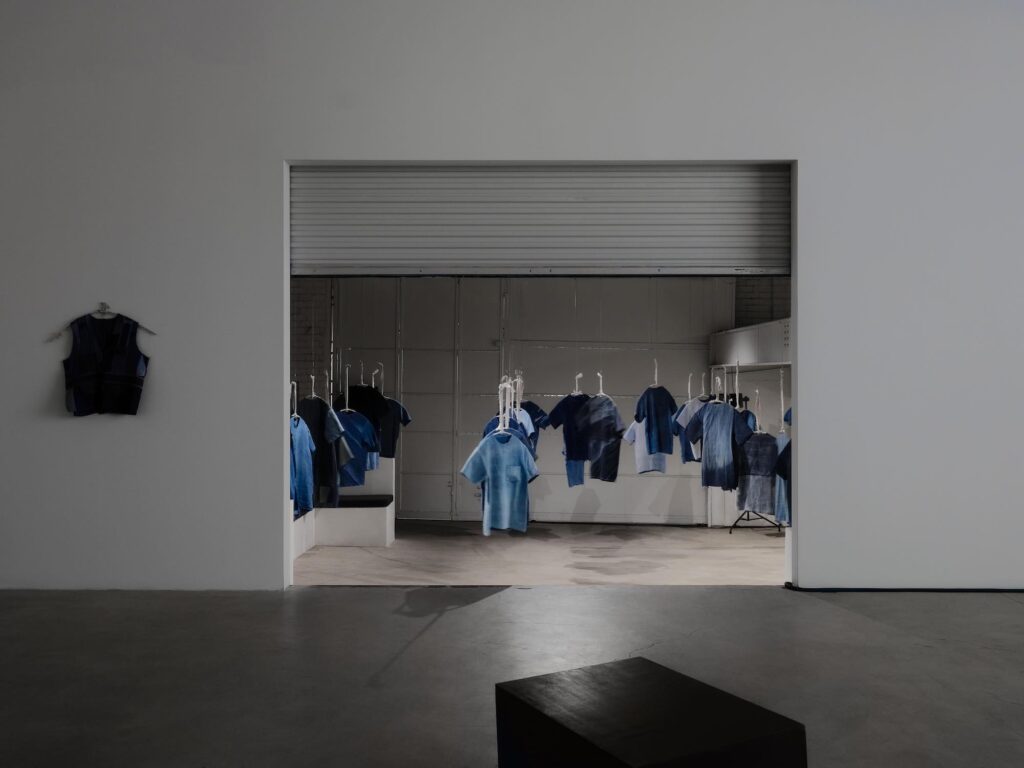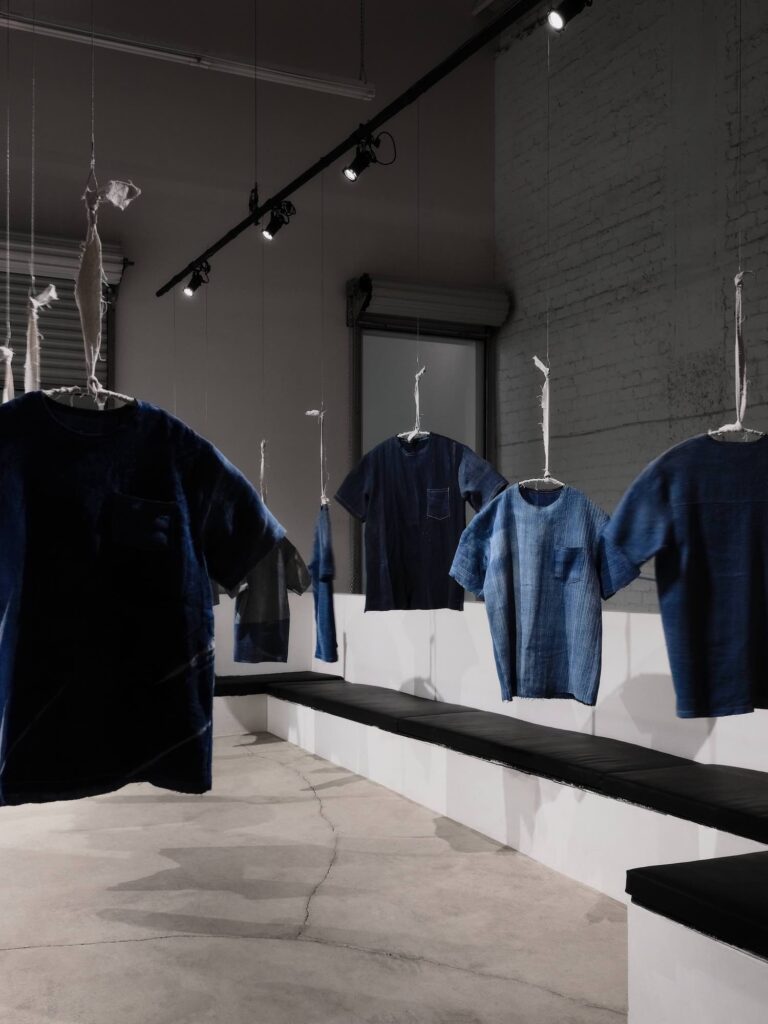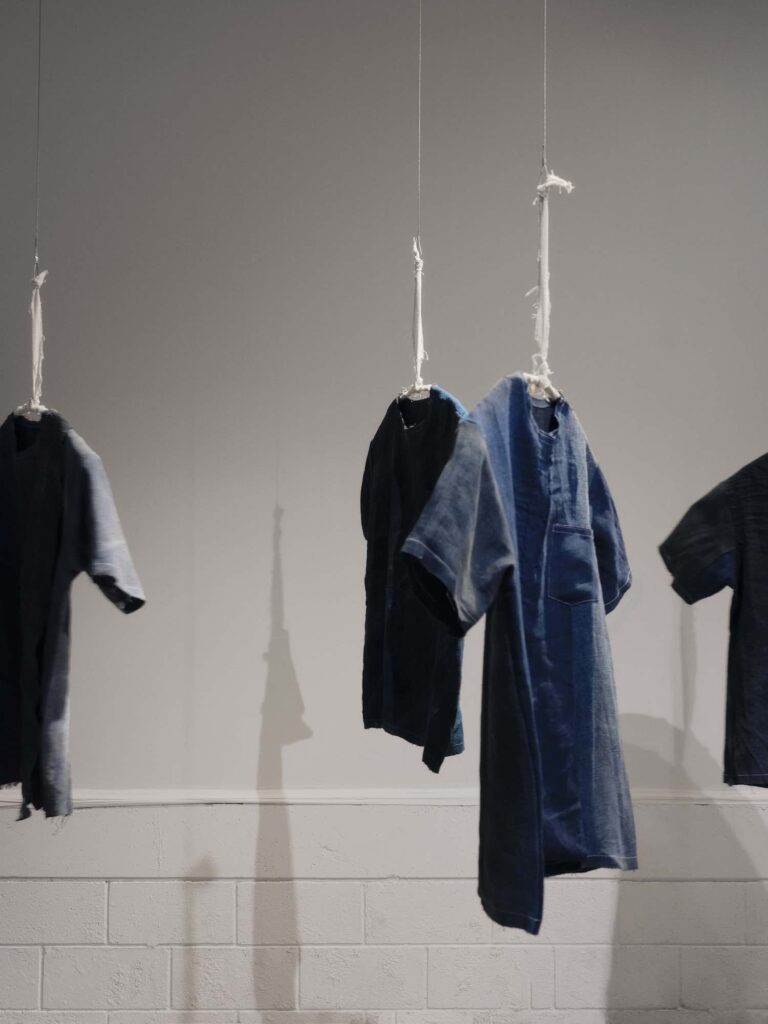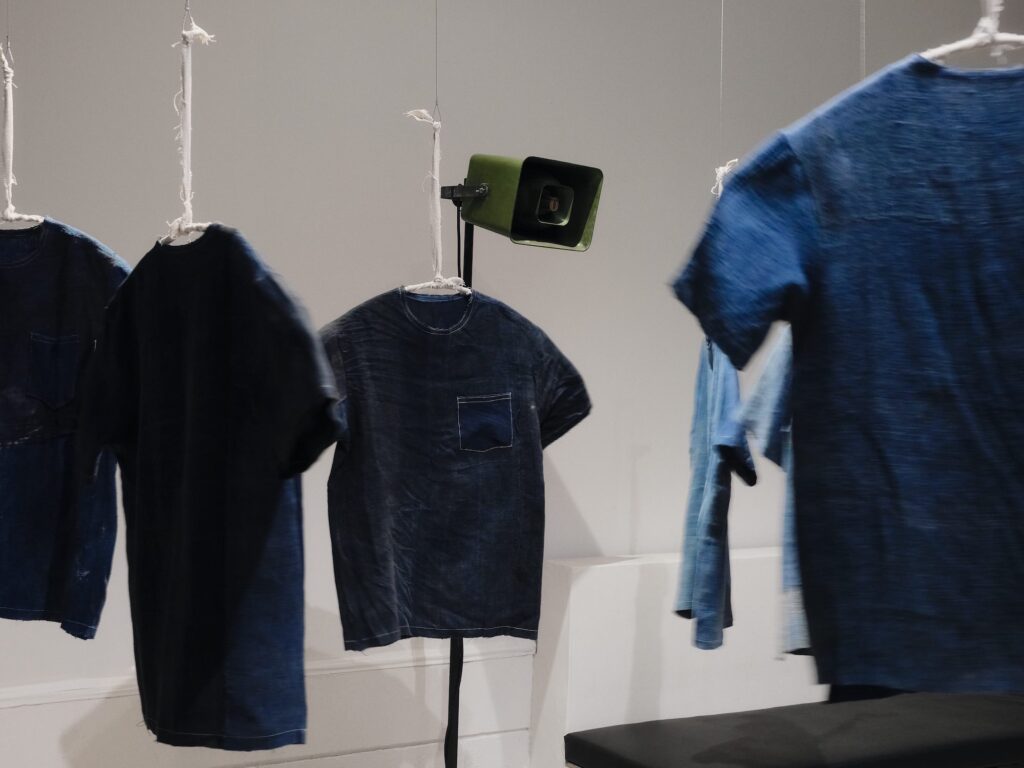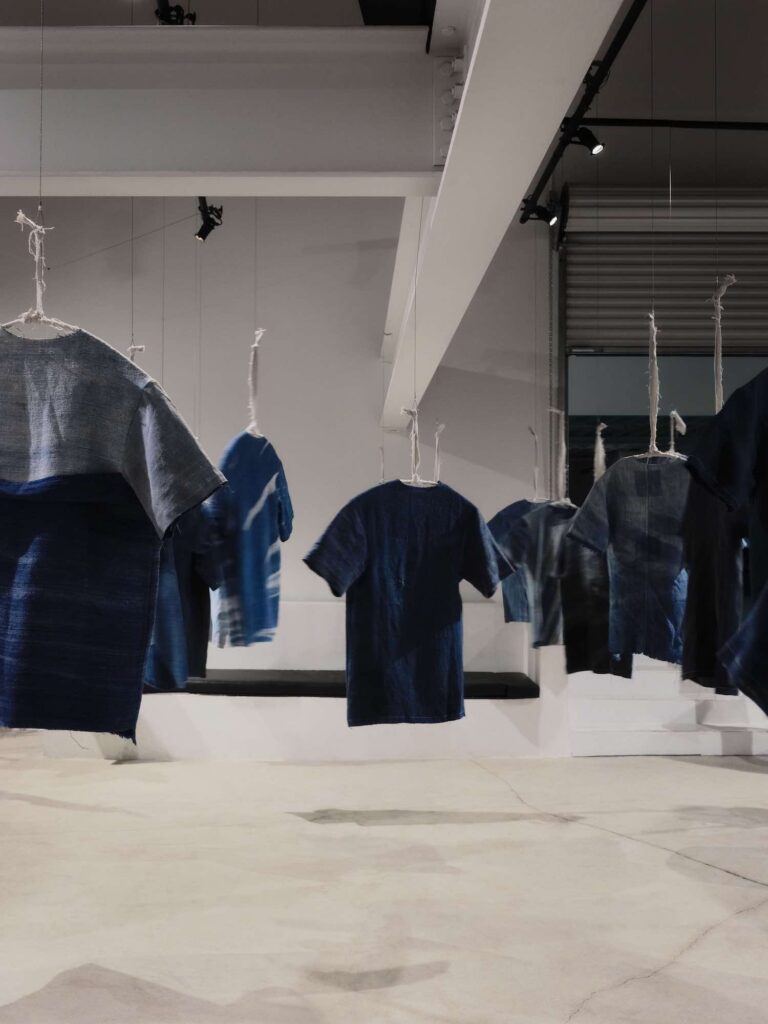Clarke & Reilly Exhibition:
Blue Collar
Interview by Team Contentsculture
You’ve worked with furniture primarily in the past, what took you in a fashion-forward direction this time?
We’ve always worked with textiles and it’s been an integral part of our work for many years. Even when our focus has been primarily on furniture, we’ve always used garments alongside them; unpicked and reused them, so for us this presentation is really more about textiles and fabric and garments rather than fashion.
However, we’ve obviously used the silhouette of the T-shirt, but we see this as a symbol and an object – to us this is no different from creating a chair, it’s still an object and that’s how we’ve approached it. We’ve always seen each of our furniture pieces as individual characters, and in the same way, we see these ‘t-shirts’ as unique characters too.
How did this project first come about?
The inspiration for Blue Collar, as with many of the projects we do, was the textile, the material object. For this presentation it was three large textile panels or ‘walls’ that we had previously installed in their entirety as part of our last presentation, AD2021, at the Howard Hughes building in LA, but we knew that they would have another life afterwards. So, after that show we took the panels and installed them outside in North California. Here they were left exposed to the elements for months, which impacted them hugely. We didn’t originally set out to do this show in this exact format, but it came about through the natural evolution of the fabric, especially after it was exposed to the elements in this way.
This was then coupled with our own visceral reaction to what was around us and what we looking at in the world. We would often go for early morning, jet-lag ridden walks around the neighbourhoods of LA at 5am, and we would witness the early morning workers as they started their days. Often these people seemed to be hidden away in non-descript buildings where you wouldn’t even know that there were people inside.
These unseen workers are making things that we, as a collective, believe we need in life. But through this exhibition we wanted to question that perceived need, and explore the distance so many of us have from the production of the goods we consume and the working class people that make them.
The textiles in Blue Collar have traveled throughout the world, why did you choose LA as their final stop?
The textiles have travelled around the world, some for over 300 years, so this is just a part of their journey – we don’t see Blue Collar as their final destination and there will be something next for them. LA made sense now because of our personal connection here, coupled with the textile industry and the garment district. Walking through these neighbourhoods in LA was a catalyst for this iteration of these textiles.
As we walk through the 60 shirts hung around the installation at Sized Studio, we hear sounds reminiscing of the inside of a factory. What was behind the choice of soundtrack for the show?
We often try to include other senses in our presentation, and in the past, we have explored sound and scent in various ways. Sound is key for us – it brings an added layer of emotion that you feel in the space.
For Blue Collar, David collaborated with composer Magnus Fiennes, which was really the perfect creative partnership for what we were trying to bring to life. The collaboration itself was a unique process, mostly due to their shared and eclectic interest in the past, history, and music, and how this can be used in different spaces. The soundscape had so many layers to it; bits of spoken word, junkyard percussion, colliery brass bands from Sheffield in the UK, all the way through to Americana period musical instruments and jazz, and that layering of historical sound was crucial to it. For us it’s so much more than sound, it’s a poem, an opera.
When you experience the installation, it can feel melancholic and even uncomfortable, as the sound is loud and repetitive. For us this is poignant as it symbolizes how factory work can be. Rather than fighting with the pieces for attention, the sound, which was created in response to the pieces, amplified them. David also wanted to tease out a sense of a jarring beauty and Magnus really delivered on that.
Magnus mixed the sound in the exhibition space itself, so that different sounds came from each speaker, which were then placed in varying corners of the space. Each speaker was unique, and we even included old factory Tannoys. This created a distinctive, site-specific experience.
Your artistic process requires thorough patience and careful observation. What inspires you about the relationship between nature, time, and textiles?
We see beauty in everything nature creates and the effect it has on objects and textiles, which then dictates the work. Nature plays a central role throughout this project. The unknown of exposing something to nature is exciting, and you get a true one-off piece that cannot be recreated.
Time is another key partner in our work. You have to be patient, there’s no other choice, and we’re ok with that. We take what nature gives us and then we respond – this is how we’ve always worked. This is part of the process of creating, of layering. You can’t fake it, or speed it up – there’s a truthfulness to it. To us, ‘nature’ also means the hand that works on it, and how you respond. We don’t plan how things unfold, the unknown of it is key – it forces us to go in certain ways which we can’t predict – but the end result is hopefully better than where you started! We consider our creations as interventions; and nature is the grandaddy of intervention.
Can you share about the process of selecting these textiles? Where do they come from?
The ‘tshirts’ were cut from three panels of textiles, 80 ft long in total, made up of pieces of material that we collected over many years and then stitched together. These textiles span three centuries and came from all over the world; the Black Country in England, the European countryside, and the Northeast of America. There were all types of utilitarian materials, 80’ x 14’ bedsheets, sacking, cart covers, and some with old repairs. After they had been assembled and stitched together, they were dyed using indigo from India, the US, and Japan, using traditional dyeing techniques.
Tell us about the distinct utilitarian designs of the shirts.
We were drawn to working with the form of the ‘t-shirt’ as it’s such an iconic symbol of the working class of America. It’s a classic form that is known and recognized worldwide. We wanted a basic form that that can easily be identified. As a utilitarian object that is worn throughout the world, it has the effect of levelling the playing field – anyone and everyone wears a t-shirt, there are rarely any barriers to wearing one.
We also liked the juxtaposition between the sense of the ‘tshirt’ being an item of clothing worn by anyone and everyone, whilst it also being manufactured by this very specific group of people, to whom we wanted to draw attention. Visitors to the show often commented that they saw the ‘t-shirts’ as individuals or humans – that each one had its own characteristics and personality, in the same way people do. How we chose to install them definitely added to that.
What does conscious consumerism look like for you?
This presentation isn’t a direct comment on conscious consumerism, but we do keep ethics at the top of mind in all of our creative choices, and always have. And for us, that’s about consuming less and consuming thoughtfully. If you’re conscious you can choose better.
Objects have a much longer life span than we allow them. We work with things that are hundreds of years old, and our work is about giving them an extended life, letting things live on and evolve. We try to show the beauty in evolution and our hope is that, in some small way, we might inspire or encourage others, or elicit some kind of response from them, so that they also see that old can be beautiful; reinvention and intervention can be beautiful.
Why did you choose Indigo as the dye?
We’ve always been drawn to indigo – the pigment behaves very differently in each application. We really enjoy how it changes and how the different weights of fabric respond to it in different ways, the depth of tone and the varying shades it creates. It’s one colour but so many colours within it at the same time, and that’s what has always fascinated us.

